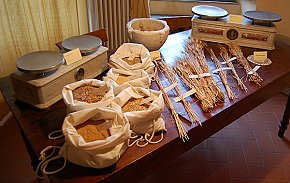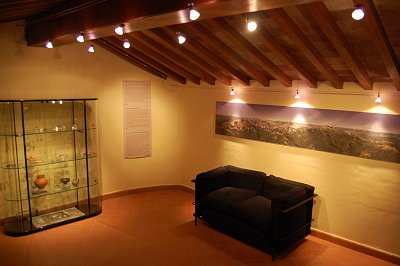|

|
Museum of Bended
Stone
Instructions
for the visit
|
|
|
Marble,
culture, territory
in 27 centuries of history
The
Museum was created from the idea of gathering in the same place the best and
most important heritage left by Apuan marble culture in the territory and
beyond over the centuries. The aim is the ostensive preservation of
“holotypes” of the most typical marble products, beginning with serial
productions, to develop specialized archeological knowledge and not to lose
artisanal and artistic traditions which unfortunately are being forgotten.
Much of the material culture of marble has been lost in 27 centuries of
history, from the beginning in the VI Cent. until today. Therefore, several
techniques and knowledge especially from the most ancient periods need to be
reconstructed through mineral archaeology. The Museum, therefore, not only
reclaims handiworks and collects them but it also functions as an applied
research centre for this particular field. Such a cultural institution is
also a fundamental element in the territorial system of sites and goods of
archeo-mineral interest which comprises historical caves and mines and
documentation centers. In 2001 the Parco
archeologico delle Apuane project (Archaeological Apuan Alps Park
Project) had already recognized their importance as examples to better
document the evolution in time of marble mining activity and production in
the region.
The peculiar name of the Museum was taken from a work by Costantino
Paolicchi in 1981 – I paesi della
Pietra piegata (Villages of Bended stone) – to represent his interest
for that specific area of the Apuan Alps where for centuries men have known
the secret of moulding and bending (“piegare”) at their will the noblest
and purest “stone”: marble.
The
Museum, planned and built by Ente Parco Regionale delle Alpi Apuane, was
opened to public on 31th may 2008. It is situated in Levigliani di Stazzema
(Lucca) in a late XVIII-century building of historic-environmental value
which was completely restored and enlarged in 1910. The exhibition is
distributed on all four floors.
|

Areas
of the Museum
ground
floor:
|
|
|

Room "Pure
and holy marbles"
|
Pure
and holy marbles (in
niveo templo)
The area dedicated to sacred and funerary art exhibits important handiworks
which testify to marble natural suitability for religious-content work of
art. Columns, capitals, balustrades, vases, sculptures and bas-reliefs with
religious images are here exhibited. It is a productive sector which in
modern and contemporary age has been the leading sector of artistic and
artisanal working techniques which use Apuan white and coloured marble.
Post council architecture choices for poor and local materials led into a
crisis the sector which for long had contributed to several studies on
sculpture, especially in Carrara, Pietrasanta, Seravezza and Querceta. |
|
|

Room "The
coulours of marble"
|
first
floor:
The
colours of marble (luxuriosa
materia)
The section is dedicated to coloured Apuan marble which nowadays is rarely
used by the mining industry but was once particularly famous and prestigious.
It was especially appreciated for its polychromatic decorations and baroque
tarsias but it almost fell into disuse for furniture and luxury products.
The windows exhibit a rich collection of ornamental coloured Apuan marble of
historical value and examples of handiworks exploiting the evocative effects
of stones polychromy. |
|
|
Stones
for houses and workshops
(locus alchemicus)
For centuries kitchens and chemist’s shops have used a common tool,
especially made of marble: mortar. Crushing of organic and inorganic
materials was a typical activity in both places. Marble and local stones
were raw materials for the production not only of mortars but also for
vessels for the conservation of oil and lard and for containers for fire.
The Museum houses a Park herbal about the flora of the Apuan Alps with exsiccata
of
plants of high naturalistic value.
|

Room "Stones for
houses and workshops" |
|
|
second floor:
27
centuries of history (marmor
signum temporum)
Thanks
to the material testimony of some marble serial but symbolic pieces of art
almost three thousand years of history come alive in a single place.
Especially architectonic work and everyday life tools mark the inexorable
passing of centuries.
Among local handiworks of historical and archeological value there are: a
non pictographic funerary cippus with half-circle crowning from the Etrurian
period; a large fragment of trabeation of an imperial Villa
Rustica; basements, kingposts and capitals from late-medieval poliforas.
Library,
archives and laboratory
It is the productive and lively area of the Museum. It preserves
bibliographic material, offers documents and instruments for studies and
research and houses the editorial office of Acta
apuana, the Park scientific magazine.
In the archives there are important deeds and maps of the history of the
territory among which manuscripts by naturalist and entrepreneur Emilio Simi
(1820-1875) need to be mentioned. The laboratory is well equipped for
petrographic and microstructural analysis on ornamental stones.
|

Room "27
centuries of history" |
|
|

Room "Apuan
Ligurian tombs in Levigliani"
|
third floor:
Apuan
Ligurian tombs in Levigliani
(…ferrum hastae, lapides
sepulcri…)
A special archaeological area exhibits ceramic findings (cinerary urns, cups,
etc.) and other type of tomb equipment (fibula, armlets, rings etc.) from
some graves dating back to the III-II century B. C. just before Roman
conquest of the territory. Worth of mentioning is a javelin tip. It is
thought to be bended for ritual purposes and it has miniature dimensions
because it belonged to a child. Graves were kept in a lithic box consisting
of five-six schist slabs with loose stones for external protection. |
|
|
Exhibited
materials derive from chance discoveries and scheduled excavations in
Levigliani necropolis which is the largest burial ground of the people of
the Apuan Ligurians in the geographic region which still keeps their name.
|
|
Instructions
for the visit
|











